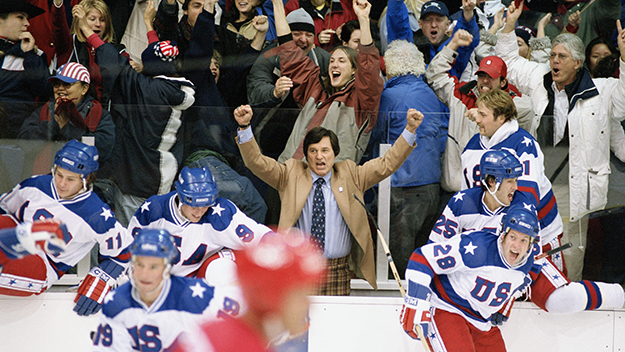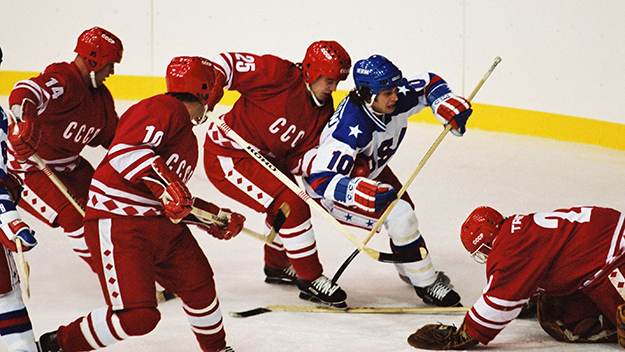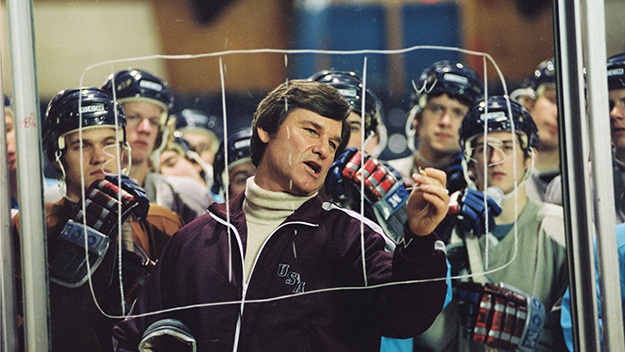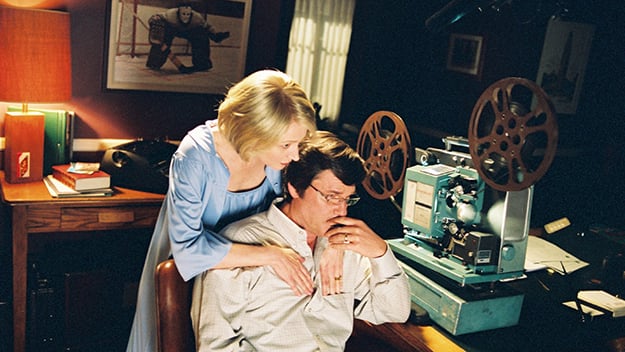Present Tense: Miracle on Ice
Present Tense is a column by Sheila O’Malley that reflects on the intersections of film, literature, art, and culture.

Kurt Russell in Miracle (2004, Gavin O’Connor)
“It was a sliver of the Cold War played out on a sheet of ice. The confluence of events was so extraordinary it can never happen again. It was the greatest sports moment of the 20th century.” – Al Michaels, ABC sportscaster
The cover of the March 3, 1980 issue of Sports Illustrated shows the jubilant pigpile of American hockey players, celebrating their improbable and historic 4-3 win over the then Soviet Union team at the 1980 Winter Olympics in Lake Placid. Heinz Kluetmeier’s photograph captures not just the players’ exuberance but their sense of disbelief at what they had just accomplished. They all look like they cannot believe what had happened. Voted the most iconic Sports Illustrated cover in the magazine’s 60-year history in 2014, it is even more striking since the image is not accompanied by a headline. In fact, there’s no text at all on the cover. As Kleutmeier commented years later, “It didn’t need it. Everyone in America knew what happened.” The “miracle on ice” of February 22, 1980 turns 40 this week. An instantly iconic event, it was voted the #1 greatest moment in sports (also by Sports Illustrated), and has been commemorated in multiple documentaries, a television movie in 1981 as well as Miracle, a 2004 feature film, directed by Gavin O’Connor, with Kurt Russell playing Herb Brooks, the tough glinty-eyed coach from Minnesota who pulled together a team of American college students to take on the most powerful hockey team in the world.
The best of these films is Bernard Goldberg’s 2001 HBO documentary, Do You Believe in Miracles? The Story of the 1980 U.S. Hockey Team (Eric Guggenheim, screenwriter for Miracle, clearly studied Goldberg’s documentary carefully). The documentary includes interviews with Brooks and the American players, as well as a couple of the Russian players. An unforgettable moment comes when Vladimir Tretiak, legendary Soviet goaltender, widely considered to be one of the greatest goalies to ever play the game, says with a grim determination to tell the truth: “We were way stronger. Nobody ever doubted that. We were professionals and they were just students. Simply put, we did not respect their team. And you cannot do that in hockey.” It’s a hell of an admission, and it hurts him to say it. To delve into the Russian side of things, Gabe Polsky’s 2014 documentary The Red Army is an essential watch: it tells the story of “The Red Army,” the Russian national hockey team, established by Stalin and developed by the “father of Russian ice hockey,” Anatoly Tarasov, who saw hockey in such innovative ways he would turn the team into the unbeatable force they would become for decades.

To give some context: In 1954, the Soviet team won their first World Championship. Two years later, they won their first gold medal at the Winter Olympics. In 1960, the Americans won the gold. A crucial bit of the “miracle on ice” myth was Herb Brooks getting cut from the 1960 Olympic team right before the games. Brooks told the story often about sitting back at home and watching on television his former teammates win a gold medal, and his father turning to him saying: “Looks like your coach cut the right guy.” The Soviet team went on to win gold medals in 1964, 1968, 1972, and 1976.(After the American upset in 1980, the Soviets won the gold again in 1984 and 1988, showing the “miracle” to be an anomaly, rather than a sea-change.) Brooks had his work cut out for him when he became coach of the 1980 team, saying, “[The Russians] could execute at such a high level of speed—skating, passing, shooting, thinking—I tried to develop a team that would throw their game right back at them.”
Gavin O’Connor’s engaging film Miracle shows that process. He lays on a pretty heavy hand, but the event is so inherently emotional already it can tolerate it. It’s the ultimate underdog story. Mark Isham’s score is gigantic, there’s no other word for it, and in a film with so many climactic events, Isham finds a way to modulate the progression, holding back, crescendoing only when necessary. It’s a masterful job. (Isham went on to score O’Connor’s 2011 film Warrior, as well as the Jackie Robinson biopic 42.) O’Connor made the choice to cast hockey players who could act a little, as opposed to well-known actors who could play hockey a little. The casting directors did a nationwide search, holding “hockey tests” on ice rinks around America and Canada. Only if the kids passed the hockey test would they be given an opportunity to read for various roles. This was a smart choice, and what you lose in acting technique and experience, you gain in heart and verisimilitude. (One of the kids who showed up for the hockey test in Minnesota was Billy Schneider, whose dad was Buzz Schneider, a member of the original 1980 team and part of the famed “Coneheads” lineup. O’Connor cast Billy as his own father.)
The 1980 game is indistinguishable from its larger context (the Soviet invasion of Afghanistan just two months prior to the Olympics games, the hostage crisis in Iran, gas rationing, inflation, blackouts, etc.) President Jimmy Carter famously addressed the nation in 1979, acknowledging the nation’s “crisis of confidence”. (In Mike Mills’ 20th Century Women, a group of people watch the speech on television, commenting afterwards in succession: “Wow. He is so screwed.” “It’s over for him.” “I thought that was beautiful.” They were all correct.) If you want to see a hockey movie steeped in 1970s malaise, Miracle is not the one to see. (Slap Shot, however, is. A raucous comedy—”They brought their fuckin’ toys with them!”—Slap Shot’s gritty atmosphere and characters weighed down by uncertainty captures the zeitgeist in a way other more “serious” message-type films did not.)

For Miracle, O’Connor had a clear vision: he wanted to bring the camera onto the ice, into the thick of the game. He wanted to recreate the famous plays: Mark Johnson’s two goals including the one made with one second left on the clock, Mike Eruzione’s slap shot goal putting the Americans ahead, and Bill Baker’s score against Sweden in an earlier game (as the Boston Globe’s John Powers said, “That was the biggest goal of the Olympics because if the Americans lose that game they’re virtually out of contention before the games even start.”) This was why it was crucial to cast kids who could play hockey at a certain level. Cinematographer Daniel Stoloff found innovative ways to get “inside” the game, using what they called a “Sledcam” (a dolly on the ice, pushed by two guys on skates), a “Polo cam”, held by a single cameraman who skated into the middle of plays, and a “Cable cam” hovering above the rink. Ryan Walter and Christopher Nelson were the hockey advisors, putting the cast through a 6-week bootcamp, where they studied the 133 actual plays included in the film. The work paid off: the end result seems to be a real game happening on the ice, not choreographed plays. The sound design favors violent clashes of pucks and sticks and ice, which is fine, but what you miss with this approach is the sound of the crowd. If you watch the original game, the crowd is, quite literally, roaring. Al Michaels, who called the game for ABC alongside Ken Dryden, said later that the sound of the crowd “had feel.”
A major annoyance in Miracle is the conception of Patti Brooks, Herb Brooks’ wife. Played by the gifted Patricia Clarkson, Patti Brooks’ story function is to be what I call the “Wet Blanket Wife,” one of my least favorite movie cliches. The Wet Blanket Wife shows up in films about “great men” and she is there to chastise him for being distracted at the dinner table. The Wet Blanket Wife usually has a scene where she stands at the doorway in a nightgown, asking her husband to “come to bed.” He may be about to cure cancer, but that doesn’t matter to the Wet Blanket Wife! There’s an entire song in Lin-Manuel Miranda’s Hamilton where Eliza Hamilton begs her husband to “take a break.” A notable exception to the trope is Annie, the wife in Field of Dreams, who gets to be an impractical dreamer too. Nick and Nora Charles in The Thin Man series almost single-handedly destroy the trope (Nick and Nora make a cameo appearance, peripherally, in Miracle, so perhaps O’Connor was trying to counteract the issue in how the role was conceived.)

But why much of this doesn’t matter, in the long run, is because Miracle is, at heart, a character study. O’Connor said, “What interested me was Herb Brooks—a guy with a specific vision and plan to revolutionize American hockey. And I thought there was an interesting movie in him.” There is, and Kurt Russell gives one of his best performances in Miracle, a performance that stands out in his career because it’s a character part, the kind he is rarely asked to do. As Brooks, Russell can’t “use” the things that make him a movie star, his charm, sex appeal, or even his humor. It was one of my favorite performances that year, and it should have gotten more serious critical attention. He went the whole nine yards: the helmet of hair, plaid pants, Minnesota accent, the tight-lipped frosty expression.Russell studied Brooks’ mannerisms very carefully. (Brooks, tragically, died in a car accident shortly after pre-production; Miracle is dedicated to him).
When the clock finally ran out on the game in 1980, and the Americans proceeded their celebration on the ice, assistant coach Craig Patrick (played by Noah Emmerich in the film) joined the players on the ice. Brooks, however, was nowhere to be found. Russell interviewed Brooks (the raw footage is included in the DVD’s special features), and asked him about the potential “loneliness” of that moment (a real actor’s question). Brooks said, in his typically stiff upper lip way, “It was a very emotional moment. I was off by myself, a reflecting type thing.”
And so O’Connor and Russell were left to imagine what Brooks was doing as the team celebrated on the ice. The moment in the film is worth the price of admission, and Russell does it all without closeups. He doesn’t need them. The sensation of triumph is so pure, so enormous, his body can’t contain it. In a career of wonderful moments, the scene in the shadowy tunnel beneath the rink, all by himself, is Russell’s finest.
Sheila O’Malley is a regular film critic for Rogerebert.com and other outlets including The Criterion Collection. Her blog is The Sheila Variations.







